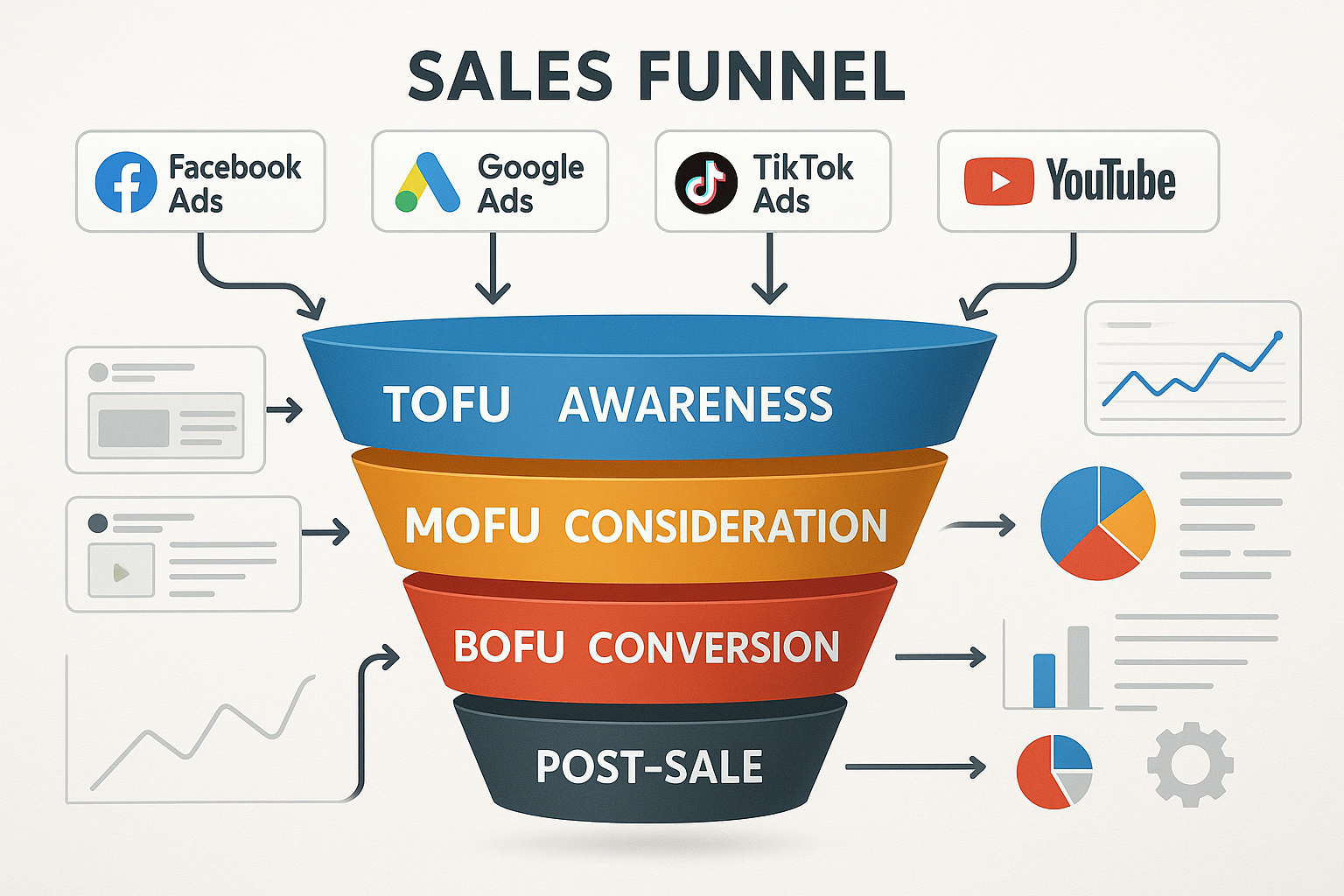Every paid traffic campaign needs a destination—and that destination should be part of a well-structured sales funnel. If you send traffic to a random homepage or poorly designed page, you’ll lose leads, waste budget, and frustrate potential customers. In this guide, we’ll explain what a sales funnel is, how it works, and why it’s essential in any successful paid traffic strategy.
What Is a Sales Funnel?
A sales funnel is the step-by-step path a potential customer takes from the first contact with your brand to the final purchase—or even repeat purchases. The “funnel” shape reflects how people drop off at each stage. At the top, you have awareness. As users move down the funnel, they consider the offer, then make a decision, and eventually convert.
Main Stages of a Sales Funnel
Top of Funnel (TOFU) – Awareness
At this stage, you introduce your brand to cold audiences. TOFU content includes educational videos, blog posts, reels, or short-form social content. Paid traffic here focuses on reach, engagement, and video views.
Middle of Funnel (MOFU) – Consideration
Now users are aware and evaluating your product or service. MOFU strategies include case studies, testimonials, free lead magnets, and product demos. Paid traffic may include retargeting based on prior engagement.
Bottom of Funnel (BOFU) – Conversion
This is the decision-making stage. Here, you show direct offers, discounts, urgency, and strong CTAs. Paid traffic is often highly segmented, retargeting warm leads with action-focused messages.
Post-Sale – Retention & Loyalty
Often overlooked, this stage focuses on upsells, referrals, reviews, and follow-up. It helps increase the lifetime value of the customer.
How Paid Traffic Fits into Each Stage
Paid traffic isn’t just about getting clicks—it should guide users through the funnel. Here’s how it aligns:
- TOFU ads: Awareness-focused campaigns on Meta, TikTok, or YouTube
- MOFU ads: Lead gen, retargeting site visitors, offering webinars or guides
- BOFU ads: Time-sensitive offers, cart abandon retargeting, sales pages
- Post-purchase ads: Customer feedback, cross-sell offers, brand-building content
Each ad should match the user’s stage and intent.
Benefits of Using Funnels in Paid Traffic
- Improved conversions: Tailored messaging moves users step by step
- Lower ad costs: Retargeting warm users is cheaper than cold traffic
- Better measurement: Each funnel stage provides trackable data
- Higher ROI: Maximizing value per user across the funnel
Building a Simple Funnel for Paid Ads
1. Awareness Campaign
- Platform: TikTok or Meta
- Objective: Engagement or video views
- Content: Entertaining or informative video introducing the problem
2. Lead Magnet Retargeting
- Platform: Meta or Google Display
- Objective: Leads
- Content: Free guide, checklist, or webinar in exchange for email
3. Sales Offer
- Platform: Meta, Google, or email remarketing
- Objective: Conversions
- Content: Product offer page, discount, urgency, social proof
4. Upsell or Thank You Page
- Offer another product or bonus
- Ask for a review or social share
Tools to Build Funnels
- ClickFunnels
- Systeme.io
- Leadpages
- WordPress with Elementor
- Email platforms like MailerLite, ConvertKit, or ActiveCampaign
These help automate and connect the funnel stages.
Final Thoughts: Funnels Turn Clicks Into Customers
Without a sales funnel, you’re just buying traffic and hoping for the best. With a funnel, every click has a purpose and every interaction builds momentum. Paid traffic only reaches its full potential when you guide users through a clear, strategic path. Build a funnel that educates, nurtures, and converts—and your ad spend becomes a smart investment instead of a gamble.

